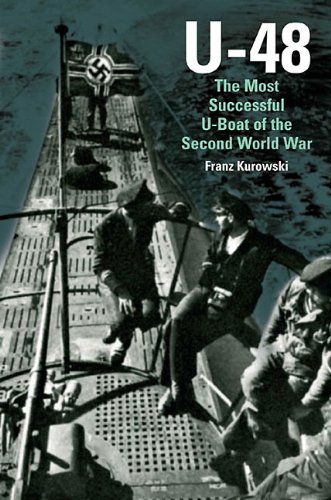Reviewed by Diana L. Ahmad, Ph.D.
Published twenty years after the death of the author, Franz Kurowski, the book focuses on U-48, the most successful U-Boat in World War 2. During the war, the author served as a Luftwaffe paratrooper with the Afrika Korps. After the war, he worked as a freelance journalist and wrote over one hundred books, including Panzer Aces: German Tank Commanders in World War II. U-48 provides a look into naval operations in World War 2 from the perspective of the Germans prior to the entry of the United States into the conflict.
The book gives readers a detailed description of how the commanders of U-48 proved incredibly successful by sinking or damaging fifty-seven vessels (322,500 total gross tonnage) in two years. Kurowski credited the leadership of U-48’s commanders, Herbert Schultze, Hans-Rudolf Rӧsing, and Heinrich Bleichrodt, as well as a few others, including watch officer Reinhard “Teddy” Suhren. While the author describes the officers in charge, he pays little attention to the design of the boat and the advantages or disadvantages that it possessed. Initially, the major flaw in the U-Boats was related to the failure of German torpedoes. While the author notes that the torpedoes often failed, he does not explain how the weapons were re-engineered to make them successful. Further, little is provided to give readers a sense of what it was like aboard U-48.
Geared for those who may understand the operations and designs of U-Boats, the book is often filled with numerous details without giving any explanation as to why they are significant. Precisely how the submarine operated, what conditions were like in the ship, and the reactions of the crew to various events are not discussed. In Kurowski’s descriptions of attacks on Allied shipping, U-48 seems only a small part of the battles, but suddenly she became the vessel with the most victories. A lengthier explanation of how that was accomplished would have been helpful to readers. U-48 participated in twelve patrols, but in June 1941, it was decided that she was technologically out of date and she was transferred to a training flotilla in the Baltic Sea, and, finally in May 1945, with the end of the war in sight, she was scuttled.
At the beginning of the conflict, Kurowski explained that according to the London Naval Treaty of 1930 it was necessary to send a shot across the bow of a vessel a U-Boat was hoping to sink. That lasted until 1939 when the Germans sank the British liner Athenia, but the author does not provide a clear explanation of when and why the rules of war at sea changed leaving the readers wondering what happened and why the rules changed. The author also does not detail the number of men lost in the battles on either side, what types of cargoes were targeted, and what impact the losses of men and supplies had on either side of the conflict.
The book contains numerous photographs yet does not provide maps of the areas of operation that ranged from the North Sea to west of Portugal and Spain. There are few footnotes and only a brief bibliography.
Diana L. Ahmad, Ph.D. teaches at the Missouri University of Science and Technology.
U-48: The Most Successful U-Boat of the Second World War. By Franz Kurowski. (South Yorkshire, UK: Frontline Books, Imprint of Pen & Sword, Books, 2021).



LCDR Roger Thomas USN Ret